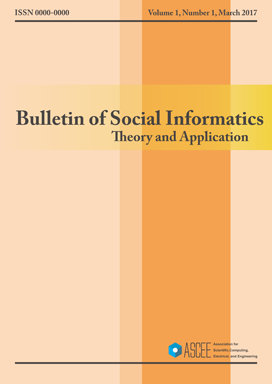Social Media and Online Prostitution Industries
DOI:
https://doi.org/10.31763/businta.v6i1.424Keywords:
Prostitution , Online prostitution, Social media, Developed country, Developing countryAbstract
Online prostitution continously increases along with the development of technology and information. This study aims to observe the development of prostitution globally, including the developed countries and developing countries. This research was conducted by collecting the world data news about online prostitution in the last ten years (2011-2021). Most of the motives of online prostitution are economic factors. Several online prostitution cases involved minors. Online prostitution cases in developed countries and developing countries occur on several social media platforms such WeChat, LINE, MiChat, and Facebook. In the discussion chapter, the writers provide suggestions to minimize the cases of online prostitution which one of them is making regulations to govern the use of social media.
References
J. O’Connell Davidson, “Prostitution,” in The Blackwell Encyclopedia of Sociology, Oxford, UK: John Wiley & Sons, Ltd, 2007, doi: 10.1002/9781405165518.wbeosp111.
V. Samarasinghe, Female Sex Trafficking in Asia. Routledge, pp. 1-234, 2012, doi:10.4324/9780203485231.
G. Ekberg, “The Swedish Law that Prohibits the Purchase of Sexual Services,” Violence Against Women, vol. 10, no. 10, pp. 1187–1218, Oct. 2004, doi: 10.1177/1077801204268647
L. E. C. Rocha, F. Liljeros, and P. Holme, “Information dynamics shape the sexual networks of Internet-mediated prostitution,” Proc. Natl. Acad. Sci., vol. 107, no. 13, pp. 5706–5711, Mar. 2010, doi: 10.1073/pnas.0914080107.
F. MacKee, “Social Media in Gay London: Tinder as an Alternative to Hook-Up Apps,” Soc. Media + Soc., vol. 2, no. 3, p. 205630511666218, Jul. 2016, doi: 10.1177/2056305116662186
S. Cunningham et al., “Behind the screen: Commercial sex, digital spaces and working online,” Technol. Soc., vol. 53, pp. 47–54, May 2018, doi: 10.1016/j.techsoc.2017.11.004
“Online prostitution uncovered in Balikpapan.” Accessed Apr. 06, 2021. [Online]. Availableat: https://www.thejakartapost.com/news/2019/08/20/online-prostitution-uncovered-in-balikpapan.html.
P. Daulay, S. Kanto, D. Wisadirana, and S. Mu’adi, “Post Closure Prostitution and The Adaptation Strategy of Sex Workers: Case Study of Dolly Prostitution Community, Surabaya Indonesia,” International Journal of West Asian Studies,vol. 10, pp. 14,2018. [Online]. Availableat: http://journalarticle.ukm.my/17693/1/30036-92048-1-SM.pdf.
R. Cempaka, B. Wardhani, A. A. S. Sawitri, P. P. Januraga, and B. Bavinton, “PrEP Use Awareness and Interest Cascade among MSM and Transgender Women Living in Bali, Indonesia,” Trop. Med. Infect. Dis., vol. 5, no. 4, p. 158, Oct. 2020, doi: 10.3390/tropicalmed5040158.
“KPAI: Social Media Eases Child Prostitution Practices -News En.tempo.co.” Accessed Apr. 06, 2021. [Online]. Availableat: https://en.tempo.co/read/1173466/kpai-social-media-eases-child-prostitution-practices.
L. R. Bennett and S. G. Davies, “Surveilling sexuality in Indonesia,” Routledge, pp. 47-68, Dec. 05, 2014. Accessed Apr. 06, 2021. [Online]. Availableat:https://www.taylorfrancis.com/chapters/edit/.
“Prostitution ring smashed, three Malaysians and 26 foreigners nabbed in Pudu raid.” Accessed Apr. 29, 2021. [Online]. Availableat: https://www.thestar.com.my/news/nation/2020/04/24/prostitution-ring-smashed-three-malaysians-and-26-foreigners-nabbed-in-pudu-raid.
E. Y. Tsang, “Finding Hope as a ‘Tempting Girl’ in China: Sex Work, Indentured Mobility, and Cosmopolitan Individuals,” Deviant Behav., vol. 39, no. 7, pp. 896–909, Jul. 2018, doi: 10.1080/01639625.2017.1335543.
“Online sex services ‘booming.’”. Accessed Apr. 29, 2021. [Online]. Availableat:https://www.bangkokpost.com/thailand/politics/349226/online-sex-services-booming.
“Social media is helping prostitution thrive online, pimps earning Rs 50 lakh annually: Study.”Accessed Apr. 29, 2021. [Online]. Availableat:https://news.abplive.com/lifestyle/social-media-is-helping-prostitution-thrive-online-pimps-earning-rs-5016746-annually-study-399699.
M. Soohoo, M. Blas, G. Byraiah, C. Carcamo, and B. Brown, “Cervical HPV Infection in Female Sex Workers: A Global Perspective,” Open AIDS J., vol. 7, no. 1, pp. 58–66, Dec. 2013, doi: 10.2174/1874613601307010058.
C. Cooke, “Decriminalizing Prostitution: Embracing the Swedish Model By Removing the Mistake-Ofage Defense From New York’S Stop Violence in the Sex Trade Act.,” Journal of Law & Policy,vol29, no. 1, pp. 248-2842020.[Online]. Availableat: https://libproxy.wustl.edu/login?url=https://search.ebscohost.com/.
“Concord Teacher Arrested On Prostitution, Child Sex Image Charges.”Accessed Apr. 29, 2021.
Bulletin of Social Informatics Theory and ApplicationISSN2614-0047Vol. 6, No. 1, March2022, pp. 7-12Zamanet.al (Social media and online prostitution industries)[Online]. Availableat:https://patch.com/new-hampshire/concord-nh/concord-teacher-arrested-prostitution-child-sex-image-charges.
Y. Dandurand, “Review of International Sex Trafficking of Women & Children –Understanding the Global Epidemic,” J. Hum. Traffick., vol. 2, no. 3, pp. 255–256, Jul. 2016, doi: 10.1080/23322705.2015.1099875.
J. Simpson and C. Smith, “Students, sex work and negotiations of stigma in the UK and Australia,” Sexualities, vol. 24, no. 3, pp. 474–490, Mar. 2021, doi: 10.1177/1363460720922733
A. Içduygu, “International Migration and Human Development in Turkey,” Munich Personal RePEc Archive, Oct. 01, 2009. Accessed Apr. 29, 2021. [Online]. Availableat: https://mpra.ub.uni-muenchen.de/19235/%0D.
C. UENO, “Self-determination on sexuality? Commercialization of sex among teenage girls in Japan 1,” Inter-Asia Cult. Stud., vol. 4, no. 2, pp. 317–324, Jan. 2003, doi: 10.1080/1464937032000113060.
W. Zukerman, “Could online prostitution crackdown endanger women?,” New Sci., vol. 212, no. 2840, p. 24, Nov. 2011, doi: 10.1016/S0262-4079(11)62895-9.
A. Lutnick and D. Cohan, “Criminalization, legalization or decriminalization of sex work: what female sex workers say in San Francisco, USA,” Reprod. Health Matters, vol. 17, no. 34, pp. 38–46, Jan. 2009, doi: 10.1016/S0968-8080(09)34469-9.
M. A. Barnard, “Violence and vulnerability: conditions of work for streetworking prostitutes.,” Sociol. Heal. Illn., vol. 15, no. 5, pp. 683–705, Nov. 1993, doi: 10.1111/1467-9566.ep11434434.
R. Permatasari and N. A. Rakhmawati, “Features Selection for Entity Resolution in Prostitution on Twitter,” Int. J. Adv. Data Inf. Syst., vol. 2, no. 1, pp. 53–61, Mar. 2021, doi: 10.25008/ijadis.v2i1.1214.
Y.-C. Lin, H.-W. Tseng, and C.-S. Fuh, “Pornography Detection using Support Vector Machine,” 16th IPPR Conference on Computer Vision, Graphics and Image Processing (CVGIP), pp. 123-130, 2003.[Online]. Availableat:http://www.bunny.idv.tw/~sbb/work/paper/CVGIP2003.pdf.
Downloads
Published
How to Cite
Issue
Section
License
Copyright (c) 2022 Bulletin of Social Informatics Theory and Application

This work is licensed under a Creative Commons Attribution-ShareAlike 4.0 International License.






